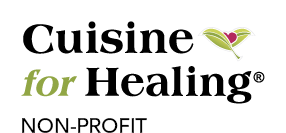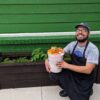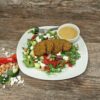Quinoa (pronounced “keen-wah”) is a versatile, nutrition packed superfood that makes a great edition to any meal, even dessert. Although quinoa is actually a seed, it is considered a whole grain, and the health benefits attributed to quinoa are almost endless. For starters, quinoa has been observed to reduce the risk of cardiovascular disease, assist in the prevention of cancer, lower the risk of diabetes, improve digestion, help prevent osteoporosis and improve circulation.
Quinoa is packed with fiber which can help regulate digestion and lower the risk for heart disease. A study from the LaTrobe University proved that adding quinoa to a normal diet for 12 weeks can significantly lower levels of triglycerides (a lipid linked to heart disease), lowering triglyceride levels may prevent artery blockage thereby lowering the risk for heart related disorders. (www.latrobe.edu.au/news/articles/2017/re-lease/study-reveals-health-benefits-of-quinoa). One serving of Quinoa contains 30% of the recommended daily dose of magnesium, 15% of the recommended daily dose of Iron and Omega-3 fatty acids. Magnesium, Iron, Fiber and Omega-3 fatty acids work to keep blood free from toxins, which can improve circulation and lead to a decreased risk of strokes. (www.healthy-hubb.com/health-benefits-quinoa/).
Quinoa is a low glycemic index food, which makes it a better substitute for regulating blood sugar than other whole grains with higher carbohydrate values. As stated above, quinoa also contains an abundance of magnesium which is especially important for not only lowering the risk of type-2 diabetes, but also consuming if a person already has diabetes as magnesium levels tend to be lower in these individuals (www.webmd.com/diabetes-/news/20031223/magnesium-lowers-type-2-diabetes-risk#1).
Quinoa has been proven to have more antioxidants than any other whole grain. One type of antioxidant called Polyphenols has been proven to protect healthy cells from damage and inhibit the growth of cancer cells. (www.eattobeat.org-/evidence/400/quinoa-a-highly-nutritious-grain-is-abundant-in-cancer-fighting-compounds.html). Quinoa also has a high amount of Quercetin (a plant pigment with high antioxidant properties) which has been linked to not only kill cancer cells, but also control blood sugar, reduce inflammation, and help prevent heart disease (www.webmd.com/vitamins-/ai/ingredientmono-294/quercetin), (www.healthline.com-/nutrition/11-proven-benefits-of-quinoa#section2).
There is a whopping eight grams of protein in one cup of quinoa. Ensuring your body gets enough healthy protein aids in prevention of osteoporosis, and building stronger muscles. Quinoa is also a complete protein, meaning it contains all nine essential amino acids. Amino acids are especially important to get from your diet, because your body cannot produce these on its own. Without amino acids your body loses the ability to store and transport nutrients as well as an assortment of other metabolic functions. (www.healthyhubb.com/health-benefits-quinoa/).
There are so many health benefits attributed to eating quinoa, if you are combating cancer, diabetes, cardiovascular disease, or other ailments and disorders, or just to trying to maintain a healthy lifestyle and diet. At Cuisine for Healing we work hard to pack nutrition into our recipes to give our clients as much of an immune boost as possible. Check out some of our Cuisine for Healing certified recipes below that incorporate quinoa into delicious healthy meals.
Orange Sesame Chicken Bowl
|
||||||||||||||||||||||||||||||||||||||||||
Orange Sesame Chicken Bowl
Serving: 4
Ingredients
- 8 Chicken Thighs
- 1⁄2 Cup Cornstarch
- 1 Tsp 5 Spice seasoning
Sauce Ingredients:
- 2 Cups Orange Juice
- 1⁄4 Cup Veggie Broth
- 1⁄4 Cup Coconut Aminos
- 3 Tbsp Honey
- 1 Tsp Garlic Powder
- 1 Tbsp Fresh Minced Ginger
- 1 Tbsp Orange Zest
Quinoa/Rice Ingredients:
- 1⁄2 Cup Quinoa
- 1 Cup Veggie Broth
- ½ Rice
- 2 Cups Water
Veggie Ingredients:
- 1 Zucchini
- 1 Onion
- 1 Carrot
- 1 Red Bell
- 2 Cloves Garlic
- 1 Tbsp Olive Oil
- 1 Tsp Sesame Seed
Directions
Cut chicken thighs into quarters and dredge the chicken in cornstarch and 5 spice seasoning, bake for 15 to 20 minutes or until the chicken reaches a temp of 165F.
While chicken is cooking, make quinoa and rice. Add quinoa and broth to a pot and bring to a boil, reduce heat and cover, simmer for 15 minutes or until the liquid is absorbed. Make rice in a separate pot. Boil rice in water checking often until rice becomes tender, around 15 minutes, drain rice once tender.
Whisk sauce ingredients together, pour into a sauce pan and bring to a boil, reduce heat and simmer for 15 to 20 minutes or until sauce begins to thicken.
Chop carrot into thin coins, chop onion and bell peppers into strips, and chop zucchini into half-moons. Heat olive oil on low heat in a sauté pan, add carrots and cook for 3 to 4 minutes, next add onions and peppers, cook for 3 to 4 more minutes, add zucchini, and cook for an additional 5 minutes, last add minced garlic and cook an additional 2 minutes. Veggies should be tender, but not mushy.
Add chicken and veggies to sauce and mix thoroughly.
Assemble Bowl:
Mix Rice and Quinoa together, top with sauced chicken and veggie mixture, add extra sauce if desired and sprinkle with sesame seeds. For a little extra flavor add green onion if desired. Enjoy!
Superfood Salad
|
||||||||||||||||||||||||||||||||||||||||||||
Superfood Salad
Serving: 4
Ingredients
- 6 Cups Kale
- 2 Cups Spring Mix
- 1 Cup Shredded Carrot
- 1⁄2 Cup Quinoa
- 1 Cup Veggie Broth
- 1⁄2 Cup Pumpkin Seeds
- 1⁄2 Cup Dried Cranberries
Dressing
- 1⁄2 Cup Olive Oil
- 1⁄4 Cup Lemon Juice
- 1⁄4 Tsp Salt
- 1 Tbsp Coco Aminos
- 1 Tbsp Honey
- 2 Tsp Minced Garlic
- 1 Tsp Nutritional Yeast
- 1 Tsp Italian Seasoning
Directions
Make Quinoa, Add quinoa and broth into a pot and bring to a bowl, reduce heat and cover, simmer for 15 minutes or until liquid is absorbed.
Mix dressing ingredients together with a wire whisk or shake in a mason jar with a lid.
Chop kale and mix with spring mix, add carrots, pumpkin seeds, cranberries, and quinoa. Toss dressing into salad and top with sesame seeds. Enjoy!









